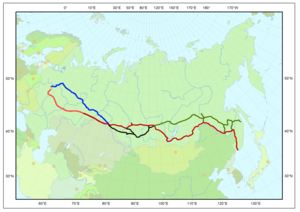Trans-Siberian Railway

Bridge over the Kama River, near Perm in 1912
|
|

Trans-Siberian line in red; Baikal–Amur Mainline in green
|
|
| Line length | 9,289 km (5,772 mi) |
|---|---|
| Track gauge | 1,520 mm (4 ft 11 27⁄32 in) |
The Trans-Siberian Railway (TSR, Russian: Транссиби́рская магистра́ль, tr. Transsibirskaya Magistral; IPA: [trənsʲsʲɪˈbʲirskəjə məgʲɪˈstralʲ]) is a network of railways connecting Moscow with the Russian Far East. With a length of 9,289 kilometres (5,772 miles), it is the longest railway line in the world. There are connecting branch lines into Mongolia, China and North Korea. It has connected Moscow with Vladivostok since 1916, and is still being expanded.
It was built between 1891 and 1916 under the supervision of Russian government ministers personally appointed by Tsar Alexander III and his son, the Tsarevich Nicholas (later Tsar Nicholas II). Even before it had been completed, it attracted travellers who wrote of their adventures. Russia has expressed desire to Pakistan for participation in China–Pakistan Economic Corridor by linking Trans Siberian railway with Gwadar Port, Pakistan.
The railway is often associated with the main transcontinental Russian line that connects hundreds of large and small cities of the European and Asian parts of Russia. At a Moscow-Vladivostok track length of 9,289 kilometres (5,772 miles), it spans a record eight time zones. Taking eight days to complete the journey, it is the third-longest single continuous service in the world, after the Moscow–Pyongyang 10,267 kilometres (6,380 mi) and the Kiev–Vladivostok 11,085 kilometres (6,888 mi) services, both of which also follow the Trans-Siberian for much of their routes.
The main route of the Trans-Siberian Railway begins in Moscow at Yaroslavsky Vokzal, runs through Yaroslavl, Chelyabinsk, Omsk, Novosibirsk, Irkutsk, Krasnoyarsk, Ulan-Ude, Chita, and Khabarovsk to Vladivostok via southern Siberia. A second primary route is the Trans-Manchurian, which coincides with the Trans-Siberian east of Chita as far as Tarskaya (a stop 12 km (7 mi) east of Karymskoye, in Chita Oblast), about 1,000 km (621 mi) east of Lake Baikal. From Tarskaya the Trans-Manchurian heads southeast, via Harbin and Mudanjiang in China's Northeastern Provinces (from where a connection to Beijing is used by one of the Moscow–Beijing trains), joining with the main route in Ussuriysk just north of Vladivostok. This is the shortest and the oldest railway route to Vladivostok. While there are currently no traverse passenger services (enter China from one side and then exit China and return to Russia on the other side) on this branch, it is still used by several international passenger services between Russia and China.
...
Wikipedia
